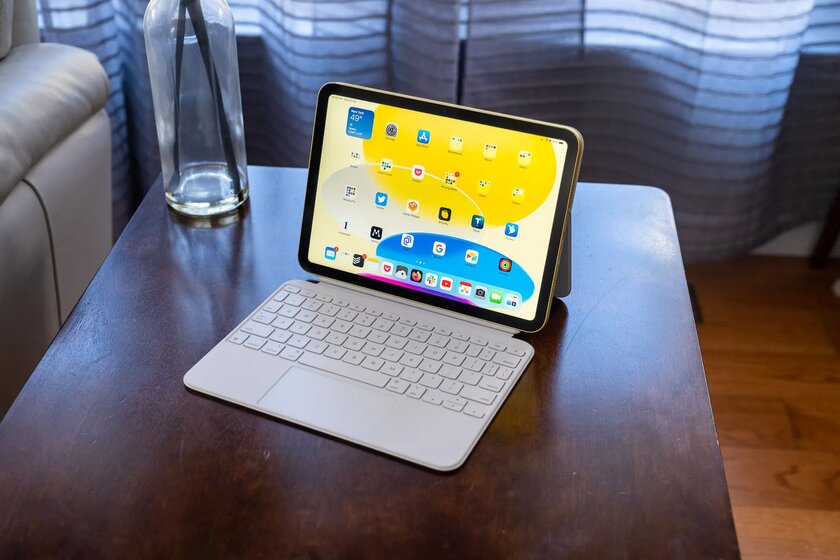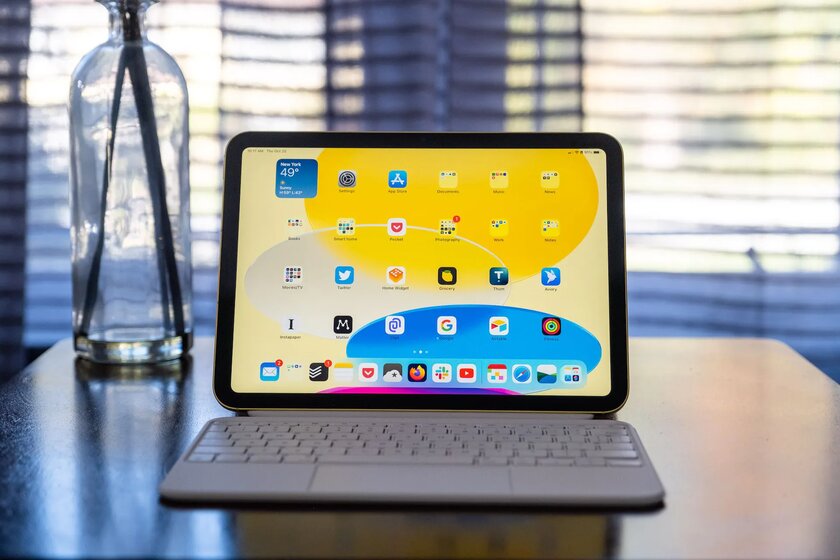The new 10th generation iPad is arguably the starting point for a new generation of iPads—it has a bigger screen, faster processor, and a modern design than the 9th generation iPad, which came out in 2021, can’t boast. At the same time, the novelty inherited some design features from the more expensive iPad Air, but the manufacturer had to go to various tricks to reduce the price. Ultimately, the new iPad is a great tablet with great performance, decent battery life, and an extensive library of optimized software, but the price of the tablet has also gone up.
Characteristics
- Display: 10.9″ Liquid Retina IPS LCD, 1640×2360 pixels, 500 nits
- Processor: Apple A14 Bionic.
- RAM: not specified.
- Internal memory: 64 GB, 256 GB.
- Main cameras: 12 MP (f/1.8, PDAF).
- Front camera: 12 MP (f/2.4, 122°).
- Operating system: iPadOS 16.1.
- Dimensions: 248.6 × 179.5 × 7 mm.
- Weight: 477 g.
A price that leaves no chance
The fact is that the iPad 10 sells for $449 in its most basic configuration, which is $120 more than the previous generation model. And if you try, then with the maximum amount of memory, cellular network and accessories, the cost of the gadget will reach $ 1,000. And we’re still talking about the entry-level iPad without the “Pro” in the name, which is bought for everyday use, kids, school, travel, and watching movies on the couch. This is not a gadget that can replace a laptop, not even close.
And Apple seems to understand the situation, because the company is still selling the 9th generation iPad for $329, which is much more attractive and affordable for many people who just want to buy an iPad for basic needs. This puts the new iPad in an extremely difficult position – it’s better than the 9th generation iPad, but it costs significantly more, and it’s not as good as the iPad Air. Accordingly, this new iPad can hardly be called a tablet for which you should run to the store.
Case design
The 10th generation iPad gives the potential buyer the square, flat-bezel, no-home button design that Apple introduced back in 2018 with the iPad Pro. In addition, the tablet is practically a copy of the last two iPad Air models – it has the same display and body size, the difference is literally in millimeters. And although the updated look of the gadget ends up looking more modern than the iPad 9th generation, since users have seen variations of the same design for four years, it is not particularly fresh language to call it. It just looks like a modern iPad and nothing more.
I’d also like to point out that Apple’s marketing materials refer to the new iPad as a “full-screen design” tablet, but let’s be honest, it’s not. The display is really big, but it still has bezels – they are very noticeable and symmetrical so that the user can comfortably hold the tablet in any position, but there is no edge-to-edge design here. Yes, and the front camera is also present here, it is very invisible, as it is hidden in the same frame around the display. This camera, not least, is now located in the long bezel of the display, allowing video calls in portrait mode with the correct camera position. Surprisingly, this is the first iPad in which Apple has ventured into such an innovation.
Display
The biggest upgrade over the 9th generation iPad, aside from the four-color design, is the larger display, now measuring 10.9 inches instead of 10.2 inches. Accordingly, it is the same as in the iPad Air, has the same brightness and resolution. It’s a good size for a tablet – comfortable enough for multitasking, watching movies, reading books, and surfing the web. Moreover, the aspect ratio is almost 3:2, so the gadget does an excellent job in both portrait and landscape orientations.

But, unfortunately, the 10th generation iPad does not have a laminated display, like the iPad Air and Pro, plus it has worse anti-glare coating. As a result, this screen is not as pleasant to look at, with a lot of reflections, backlight problems at certain viewing angles, and a noticeable gap between the glass and the LCD panel. And these problems are hard to forgive when it comes to a $449 tablet.
Ports and fingerprint reader
Apple engineers have moved the Touch ID fingerprint scanner from the iPad Air and Mini, which is now also located in the power button on the left side of the device. It works quite well, although it’s certainly not as simple and convenient in everyday life as the Face ID system in the iPad Pro. In addition, now the tablet received a USB Type-C port instead of Lightning for data transfer and charging. Thanks to this, the choice of accessories and the selection of charging will be noticeably simplified, especially if the user wants to purchase a docking station. However, potential buyers of this tablet, most likely, will never connect an external monitor. But the lack of a headphone jack raises questions – many schools and parents buy an entry-level iPad for children. For them, the inability to connect wired headphones will be a big problem.
Performance and hardware
In terms of hardware, the 10th generation iPad is also an exact replica of the fourth generation iPad Air (2020) – it runs on the A14 Bionic processor, comes in only two internal memory options (64 and 256 GB) and works with Wi-Fi 6 While the A14 Bionic is certainly nowhere near as powerful as the M1 and M2 processors that Apple is already putting into the iPad Pro, I was shocked by the power of this device. From running multiple apps at the same time to quickly and smoothly switching between games like Genshin Impact, this iPad effortlessly handles the same tasks I usually do on my 11-inch iPad Pro M1.

Accordingly, Apple currently has four different processors (five if you include the 9th generation iPad, which is still available) in its iPad lineup. But with the exception of some incredibly demanding apps, absolutely every iPad I’ve used works pretty much the same. So if you’re upgrading to this iPad from a much older model, you’ll definitely notice a faster tablet experience. But, on the other hand, you will get faster performance in the case of the 9th generation iPad with A13 processor, only in this case you will save $120. It really struck me that I used this iPad in the same scenarios as my personal iPad Pro and it did just fine. If it wasn’t for the lower quality of the display, I wouldn’t have noticed the difference between these devices.
autonomy
Battery life is exactly what we’ve come to expect from every iPad that’s been introduced over the past decade. The tablet works for at least 10 hours in everyday tasks, or about 6-7 hours if you load it with office work and heavier software. This is more than enough for productive work. In addition, the tablet has optional sub-6.0GHz 5G support, which makes it extremely useful if you don’t have Wi-Fi on hand, but you’ll pay a whopping $150 extra for it, and 5G battery will drain noticeably faster. Yes, and for this money you can already look towards the iPad Air.
Too expensive accessories
Although the 10th generation iPad is similar to the iPad Air or iPad Pro in terms of design and body, these tablets do not share common accessories. Instead, Apple released a $249 Magic Keyboard Folio for the new tablet. Yes, that’s 55% off the starting price of the tablet itself – if you take the 10th generation iPad with keyboard, you get $700. Typing on this keyboard is extremely pleasant, the keys are large, and the trackpad is even larger than the Magic Keyboard, but there is no backlighting here, which, of course, at this price is a huge omission. And, of course, working on it from your knees is extremely inconvenient.

Another strange situation concerns the stylus – the 10th generation iPad does not work with the second generation Apple Pencil, although this accessory has been on sale since 2018. A tablet released in late 2022 only works with the first generation Apple Pencil, which was released in 2015. But the 10th generation iPad has been stripped of the Lightning port needed to pair and charge the stylus, so the user has to pay $99 for an Apple Pencil and then buy a $9 dongle to connect it to the tablet and be able to charge it. Why can’t Apple implement support for the second generation of the stylus? The question remains unanswered.
Review
In a spherical vacuum, the new 10th generation iPad is very difficult to complain about – it’s a great tablet that easily performs all the tasks assigned to it, it is capable of literally everything that you can ask from a tablet. While it doesn’t have as good a display as other iPads, it’s still decent enough and its performance is flawless. If this was the only iPad that Apple sells, many people would buy it and be absolutely happy with the purchase.

But in the context of the entire range of iPads that Apple currently owns, it’s hard to imagine that the user would choose this particular model. If cost is an important factor for a potential buyer, or the tablet is bought for a child, or the user simply needs a headphone jack, then the 9th generation model, which is also cheaper, is much better suited. For most users, the 9th generation iPad is the best tablet. If the user wants a larger display and a more modern design, then it is better to look towards the iPad Air, which has a much better screen, a faster processor and a much nicer range of accessories. And you can get all this for just an extra $100.
It is likely that this particular iPad will become the entry-level iPad at some point, completely replacing the 9th generation. And we can only hope that by that time the manufacturer will slightly reduce the price and return the headphone jack (which is unlikely). Until then, the 10th generation iPad looks like a weird midranger, not a budget iPad at all in Apple’s tablet lineup.
✅ Benefits
- High performance.
- Decent battery life.
- Huge range of applications optimized for tablets.
- The screen is larger than before.
- USB Type-C
❌ Disadvantages
- Too expensive accessories.
- The screen is not as good as other iPads.
- The starting price is much higher than expected.
- There is no headphone jack.
This is a translation of The Verge review.
Source: Trash Box
I am Joyce Corbett and I have been working in the news industry for over 10 years. My current role is as an author at World Stock Market, where I focus primarily on the tech section. My specialty is creating engaging content that helps to explain and demystify complex financial topics.







